Demography is the study of population: its size, growth,
geographic distribution, social and economic composition, and anything
which might influence or be influenced by such variables.
It has been customary to credit Thomas Malthus (Essay on
Population, 1798) with discovery of the field. In fact, his
diatribe on the evils of overpopulation, coupled with his clergyman's
opposition to any practical means of limiting it, stole the limelight from
its much earlier and certainly less inflammatory founder.
John Graunt
(1620-74) was a London haberdasher. Of his life little is
known, but in 1662 he published the book which gave birth to demography:
Observations on the Bills of Mortality (a title much
abbreviated from the original). The Bills were weekly accounts of the
cause of death in London and surrounding parishes. Subscribers used them
to warn of periodic returns of the plague, an alert to get out of town
until it subsided.
Graunt used Bills summarizing nearly a quarter million deaths to satisfy his
curiosity. He was the first to determine the distribution of deaths by age, by time
of year, by occupation. He used data on christenings to determine that more boys were
born than girls, but that their higher death rates evened things out at
about the age of reproduction. He proved that the city had a higher death rate than
the countryside (opposing then-accepted belief) and showed how to calculate the number
of men of fighting age from estimates of national population. He had a very modern
sense of the fallibility of data and suggested ways of overcoming bias in
reporting.
Merchant-gamblers at Lloyd's coffee house were quick to seize on Graunt's findings to
improve their odds, betting on the survival rates of those to whom they entrusted
their ships -- the beginning of life insurance. Other contemporaries of Graunt added
topics and methods to the field. William Petty (1623-87) was the first to prepare
population projections (if present trends continue...) and to study un-
and under-employment. Edmund Halley (of comet fame, 1656-1742) was the first to
create an empirical life table -- detailed statements of life expectancy
used by modern insurers. Gregory King (1648-1712) provided England with its first
complete population estimates.
 |
|---|
| Demographic Stamp Issues |
Censuses have been conducted as far back as the dawn of history. An Egyptian census in 3050 B.C. was part of the planning which preceded construction of the pyramids. Ancient censuses served as tax and military rolls and were no doubt very unpopular. Yahweh was so angry when David ordered a census (1 Chr 21) that he sent a pestilence which killed 70,000 men.
Happily for demographers, the census is now thought to be more helpful than not, and most countries publish the results on a regular basis. Population distribution, once thought of as a state secret (the word statistics derives from state numbers), became public information when the then-revolutionary U.S. Constitution required a census every ten years from 1790 as the basis for apportioning seats in Congress. England and France began census-taking in 1801 (most Commonwealth countries continue to take censuses in years ending in 1). By 1900 there were 44 nations conducting population censuses, and today about 96 percent of the world's people are regularly counted.
The first nation to issue a census stamp was Japan. Tradition tells of a population count as early as AD 610, and household registers (koseki) survive from as early as the 7th century. In 1721 an edict required these to be compiled nationally every six years. The first Japanese census by means of a canvass of households was in 1920. The stamps publicizing it (Scott 159-60) showed a census-taker from AD 652.
 |
|---|
| Japan (Scott 159) |
The next census stamps also came from Japan and honored its second census. The pair pictured a map of the Empire as of 1930 (Scott 208-9). A 1940 set signaled a census for Japan's puppet state, Manchukuo (Scott 134-5); one showed a census-taker, the other a census form The only other pre-WWII stamps were issued by Romania (Scott, 380-3) for its first census in 1930, Mexico (Scott, C100-2) in 1939 for the census of 1940, and Turkey (Scott, 851-4) for its 1940 census.
 |
|---|
| Belgium (Scott 732) |
The earliest demographic topical not tied to a census was issued by Germany in 1944 (Scott B253-6). This set honors the tenth anniversary of Mother and Child Aid, a euphemism for the Nazi fertility campaign. In addition to censuses of population and housing, governments conduct special censuses on such topics as agriculture, industry, or government itself. The earliest of these was Italy's 1951 stamp (Scott 590) for the 3rd Census of Industry and Commerce. Its companion (Scott 591), honoring the 9th General Census, shows a sculpture of an ancient Roman census- taker. For about 800 years Roman citizens were counted every five years. Extension to the entire Roman Empire in 5 BC is mentioned in the Bible (Luke 2:1): Now it came about in those days that a decree went out from Caesar Augustus, that a census be taken of all the inhabited earth. That census is commemorated in a demographic-related Belgian stamp (Scott 732) picturing a detail from Peter Brueghel's The Census at Bethlehem.
Techniques of recording and analyzing demographic data have been depicted on stamps. Denmark (Scott 726) notes the 400th anniversary of its Records Office with the quill pen which provided most of the data for historical demography. Iraq's set for the 1965 Census (Scott 390-2) displays graph paper and an electronic adding machine, and the Dominican Republic's 1977 set for the 7th Conference on Inter-American Statistics proudly shows off a floor model computer.
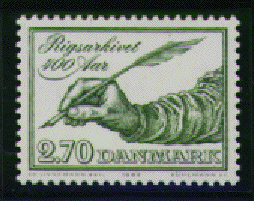 |
|---|
| Denmark (Scott 726) |
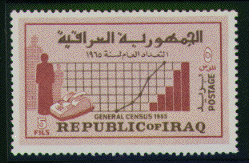 |
| Iraq (Scott 391) |
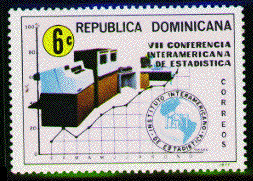 |
| Domincan Republic (Scott 790) |
One of the most useful graphic devices for displaying the demographic structure of a nation is the population pyramid, a bar graph of the male and female populations distributed by age. The pyramid shape is typical of less developed nations: very high birth rates produce a broad base of infants and children, bars which shrink rapidly with increasing age due to high death rates. More developed nations tend to have a shape more like a silo: low birth rates (small base) and low death rates (everyone survives into old age).
A German stamp commemorating the 100th anniversary of Social Security Pension Insurance (Scott 1582) shows three graphs (1889, 1989 and 2000). In addition to the change in overall form from a century ago, the graphs display the bumpiness which results from birth rates lowered by war and depression. They also reveal the extremely low birth rates of recent decades, the effects of which will be felt as older workers seek to retire in spite of a shrinking labor pool. This is a good example of the way in which an everyday item such as a postage stamp can communicate complex information or propaganda: one could be induced by this stamp to think about the pros and cons of future health care or retirement programs, or whether to open or close the border to foreign workers.
 |
|---|
| Germany (Scott 1582) |
As an abstract form the pyramid appears in census stamps for Algeria (Scott 583) and, appropriately, Egypt (Scott 1423). The most elaborate presentation of an actual graph is from Austria (Scott 1120). It commemorates the 150th anniversary of the Central Statistical Bureau. I regard it as the finest demographic stamp. The numbers of males and females are shown by single year of age, color coded by marital status (single green, married rose, divorced white, and widowed blue). Historical periods (war, depression) are indicated to the left side. To the right sits a baroque angel holding a measuring instrument of some kind, a reminder that modern statistical procedures go back as far as, and no further than, the baroque era.
 |
|---|
| Austria (Scott 1120) |
Two demography related individuals have received postal honors. The Belgian astronomer turned statistician, Adolphe Quetelet (1796-1874), gathered extensive demographic data to study the average man and promoted standardization in gathering and reporting demographic data. His death centenary was honored by Belgium (Scott 885).
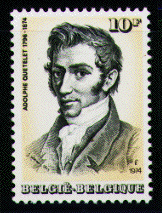 |
|---|
| Adolphe Quetelet (Belgium, Scott 885) |
Auguste Comte (1798-1857) was so angry when he heard that Quetelet had already published a book on Social Physics that he discarded that name for the field he claimed to have invented and coined Sociology for it instead. While not a demographer himself, Comte clearly saw the importance of the demographic base in any study of society -- more clearly, one might argue, than have his more psychologically or ideologically oriented successors. His death centenary was honored both by his native France (Scott 848) and by Brazil (Scott 854).
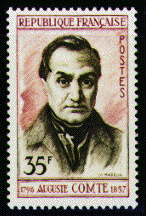 |
|---|
| Auguste Comte (France, Scott 848) |
Though never honored himself, the one who spawned the greatest number of non-census demographic topicals has to be Thomas Malthus (1766-1834). His forebodings about overpopulation came to life in the middle of this century. In 1945 the demographer Kingsley Davis wrote: Viewed in the long run, earth's population has been like a long, thin powder fuse that burns slowly and haltingly until it finally reaches the charge and explodes.
It took humanity 170 million years, more or less, to produce its first billion (1800) and another 125 years to double that (1925). We added a 3rd billion in 34 years (1959), another 15 years later (1974) and passed 5 billion 12 years after that (1986). By 1997 we are to have reached 6 billion.
Virtually all of this rapidly accelerating growth is occurring in the less developed nations. The optimistic view in the 1950s was that such nations would go through a demographic transition, industrializing just as Europe had and, with rising standards of living, lowering their birth rates. Overlooked was that fact that it took hundreds of years for Europe to industrialize and that she did so in a non- industrialized world.
Without economic well being as an incentive to lower birth rates, nations must turn to family planning programs. The first stamp to promote Family Planning was issued by Korea in 1965 (Scott 471), showing scales balancing families with houses. Other early issues of Family Planning stamps were in 1966: India (442); 1967: Chile (362, C272); 1969: Pakistan (266), Indonesia (761-2); 1970: China, Rep (1694-5) and in 1972: oddly enough, the United States (1455). I say oddly because virtually every other Family Planning stamp is from the third world, none are from Europe, and the U.S. would later (under President Reagan) pull out of all international family planing programs.
 |
|---|
| United States (Scott 1455) |
The U.N. issued three stamps in 1965 (Scott 151-3) which called attention to population problems. It followed with a 1974 set for World Population Year -- New York (253-4) and Geneva (43-4). At least twenty other nations joined in issuing WPY sets, including the smallest nation to issue an demographic stamp, St. Kitts-Nevis (280-3, 1991 pop. was 40,293), and the world's fastest growing nation, Kenya, combined in Kenya-Uganda-Tanzania (296-9). A third U.N. set honored the International Conference on Population in 1984 (UN NY, 417-8; Geneva, 121; and Vienna, 39).
 |
|---|
| Pakistan (Scott 361) |
I have counted 211 demographic sets comprising 395 different stamps (this rivals my other collecting interest, baseball). The number is determined by my cut-off date (1991) and by what I included under the label demographic (primarily censuses and family planning). The list could have been made much longer by including stamps having to do with mortality reduction (programs of food production or disease eradication, for example), urban and regional planning, race and ethnicity, or refugee programs.
Even within the fairly narrow limits I have used, however, the list seems to overlook many possibilities. It amazes me that the United States, which invented the decennial published census, should have so little in the way of stamps to show for it. Aside from the Family Planning stamp, there is only a postal card (Scott UX53) issued in 1965 in honor of the 175th anniversary of the first census. Nothing for the 200th anniversary of the oldest continuing census in the world! By my count 55 women have been explicitly honored on 65 U.S. stamps, but not one has been issued for the founder of Family Planning in the U.S. (as well as in Japan and China), Margaret Sanger (1883- 1966). There is no stamp honoring Charles Knowlton (1800-50), a physician whose 1832 book on methods of birth control earned him a three month jail sentence.
Perhaps still more disturbing is the complete lack of demographic material from Great Britain. Not one of the early demographers -- Graunt, Petty, Halley, King -- is honored as such with a stamp. Halley appears on many stamps, but only in commemoration of his predicting the return of a comet, not his contribution to demography, which has probably had a far greater effect on all our lives.
A more recent English candidate, so far unhonored, would be William Farr (1807-83). During his forty years as England's first Register General he invented the modern system of registering vital events (births, deaths, marriages, divorces). He improved census-taking, produced the first official life tables, and focused attention on a subfield demographers had neglected, fertility.
Why the neglect? Because Parson Malthus had made birth control a topic of heated moral debate, much like abortion today. Francis Place (1771-1854), the founder of England's birth control movement, was arrested for distributing diabolical handbills. Charles Bradlaugh (1833-91) and Annie Besant (1847-1933) were fined £200 and given 6 months in jail for publishing Knowlton's book on birth control. None of these people, not even Malthus, appears on a British stamp.
Another demographic philatelic black hole contains virtually all of the nations of nominally Marxist ideology. I find this surprising since Marx considered population -- not the kings and leaders often pictured on stamps -- to be a fundamental driver (force of production) in history. He attacked Malthus' argument about the relation between population and food supply, saying that it was capitalist class, not nature, which was stingy, but Marx seems to have added little more to demography than Malthus, invective always being easier to supply than new empirical knowledge.
There is one Russian demographic stamp (2156-7). It publicized the 1959 census, much of which was suppressed. Family planning was a thorny policy problem for the U.S.S.R. because the government was pronatalist with the regard to its European part while being antinatalist toward its Moslem part. It would be hard to imagine a single stamp satisfying both policies.
A similar conflict faced the People's Republic of China, earth's demographic billionaire. It took poetic form: whether to view extra children as hands (workers) or mouths (to be fed). No demographic stamps were issued till the policy conflict was resolved. An issue of 1981 (1721-2) commemorates a Population and Development conference. The 1982 census was given a stamp (1790). And in 1983 a pair of stamps (1883-4) promoted the least Marxist, most aggressive and coercive program of birth control ever pursued, the goal of one-child per couple.
 |
|---|
| China (Scott 1883) |
Census-taking has been pictured many times on stamps. Already mentioned: the seated census-takers from Japan and ancient Rome, the travellers pictured by Brueghel on their way to be counted in the city of their origin, the official of the puppet government in Manchukuo who appears to be ordering the viewer to complete a census form. Nepal (Scott 490) shows a census taker out in the field, interviewing a family. Fitting for demographilatelists, today's census-takers are for the most part the letter carriers who deliver the self-mailed census forms to our homes.
I mentioned above my fondness for the technical and esthetic achievement of the Austrian population pyramid stamp. I would like to finish this piece by calling attention to my nominee for the most delightful bit of whimsy pictured on a demographic stamp, Korea's recent stamp (Scott 1611) publicizing the census of 1990. For all the Malthusian gloom in parts of the demographic world, the very colorful peas in this pod are smiling.
